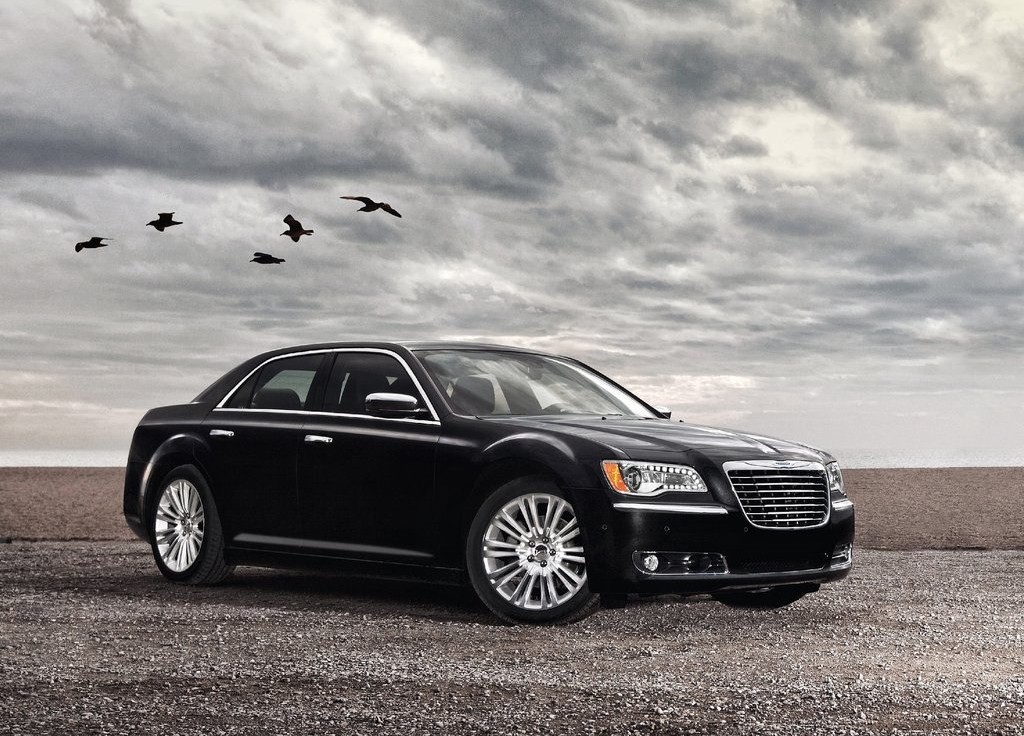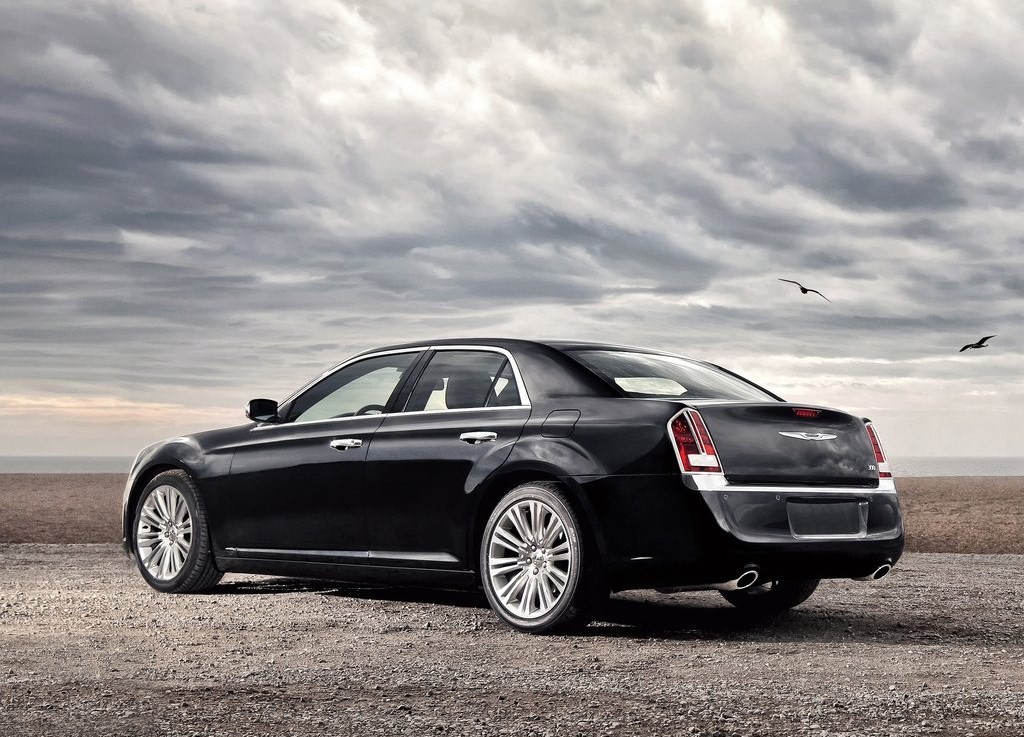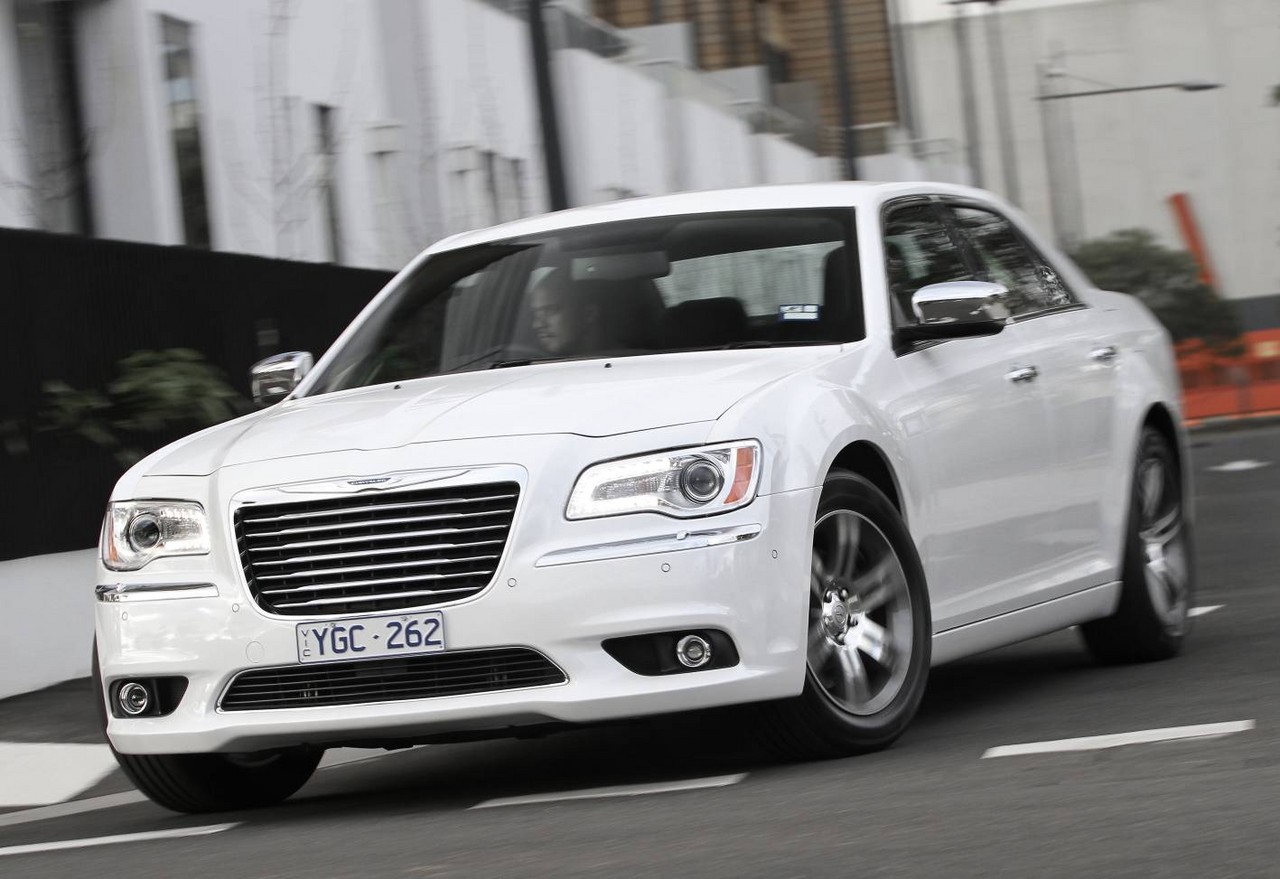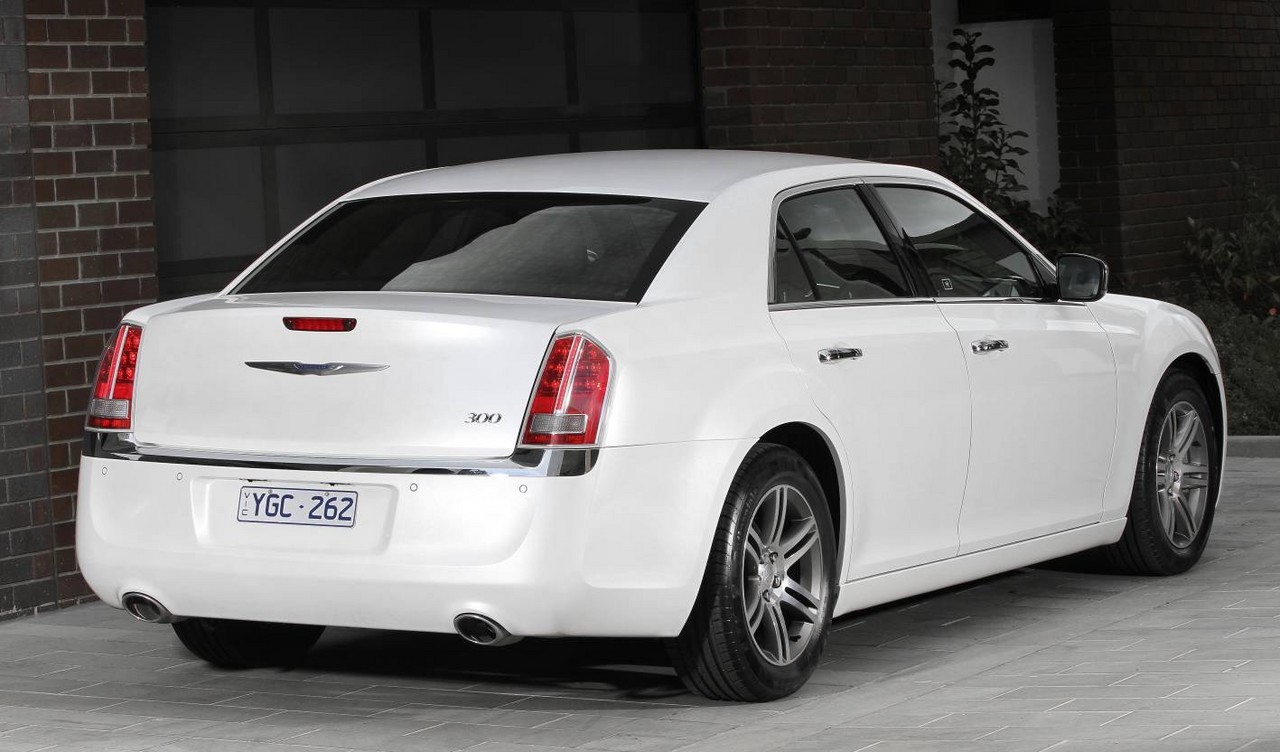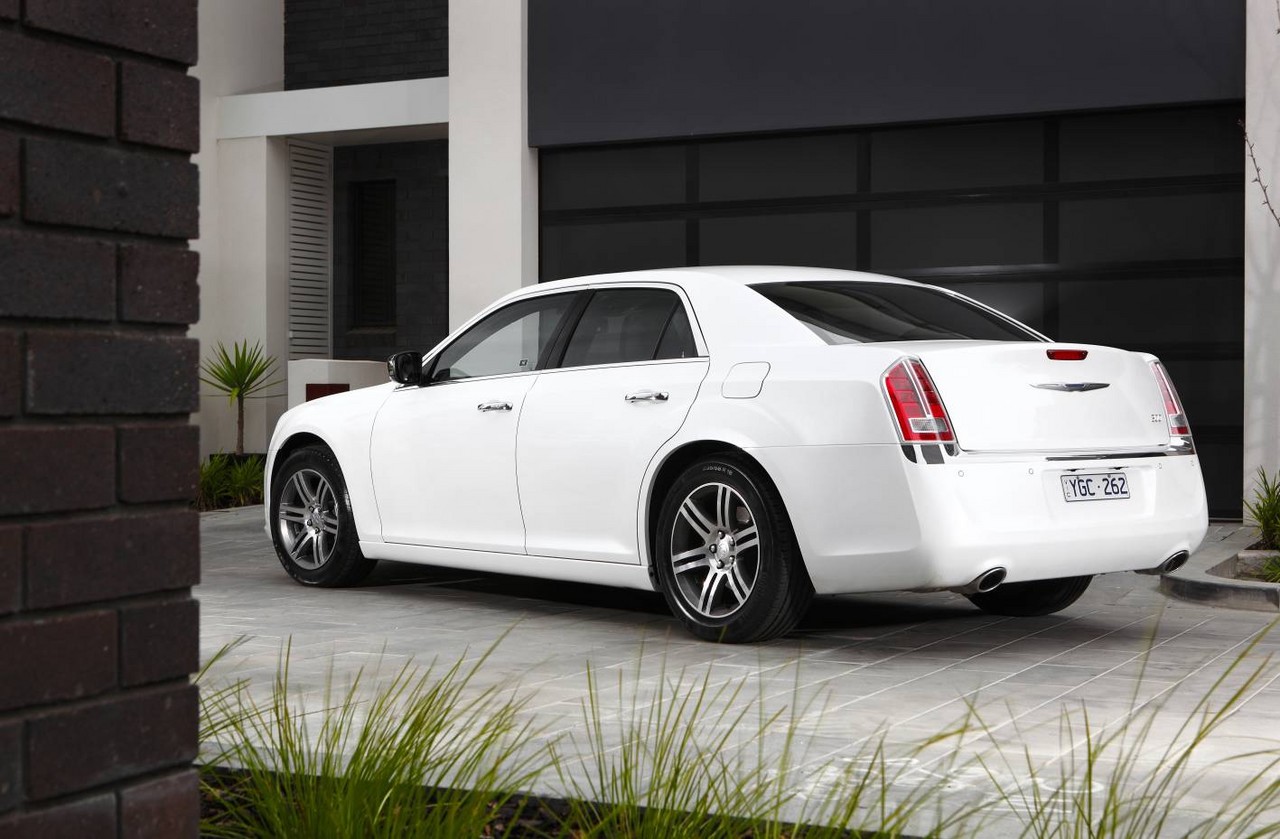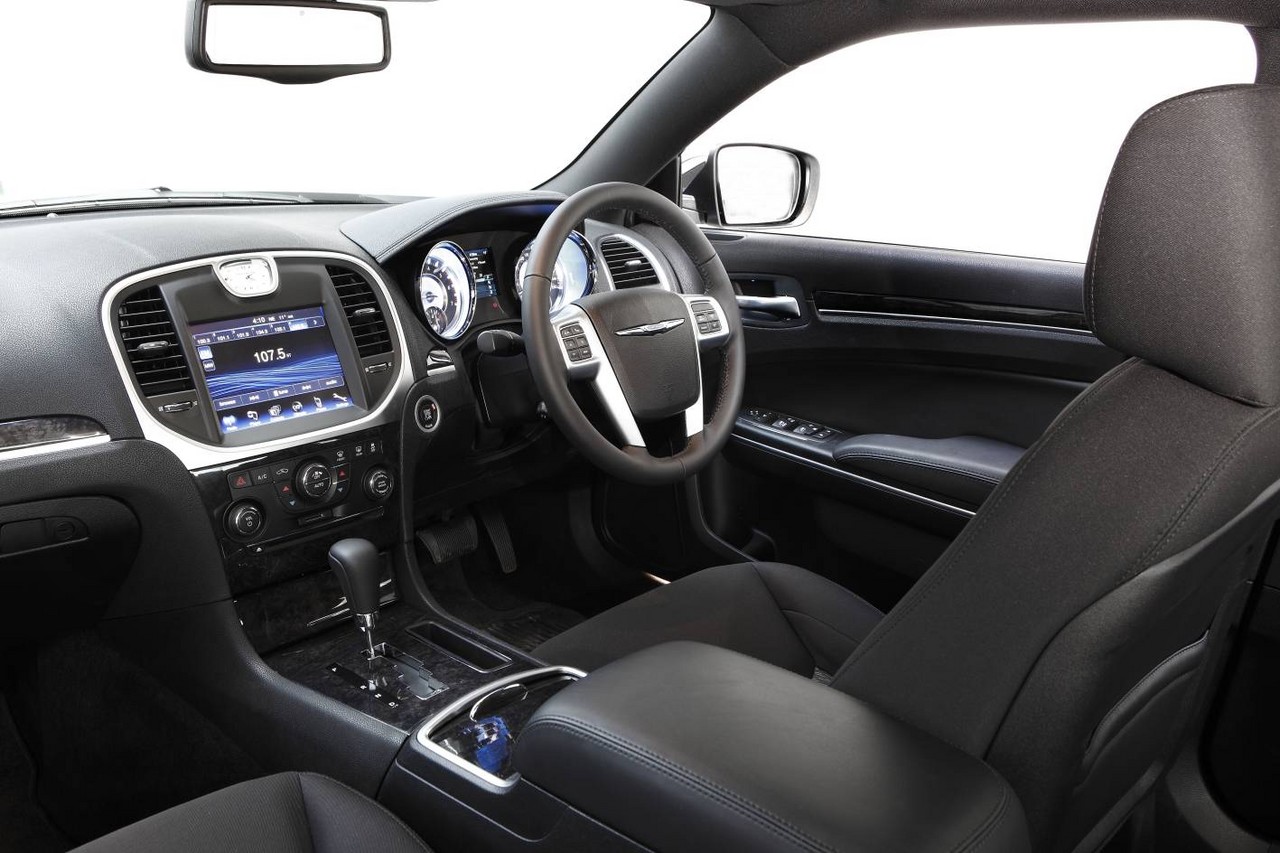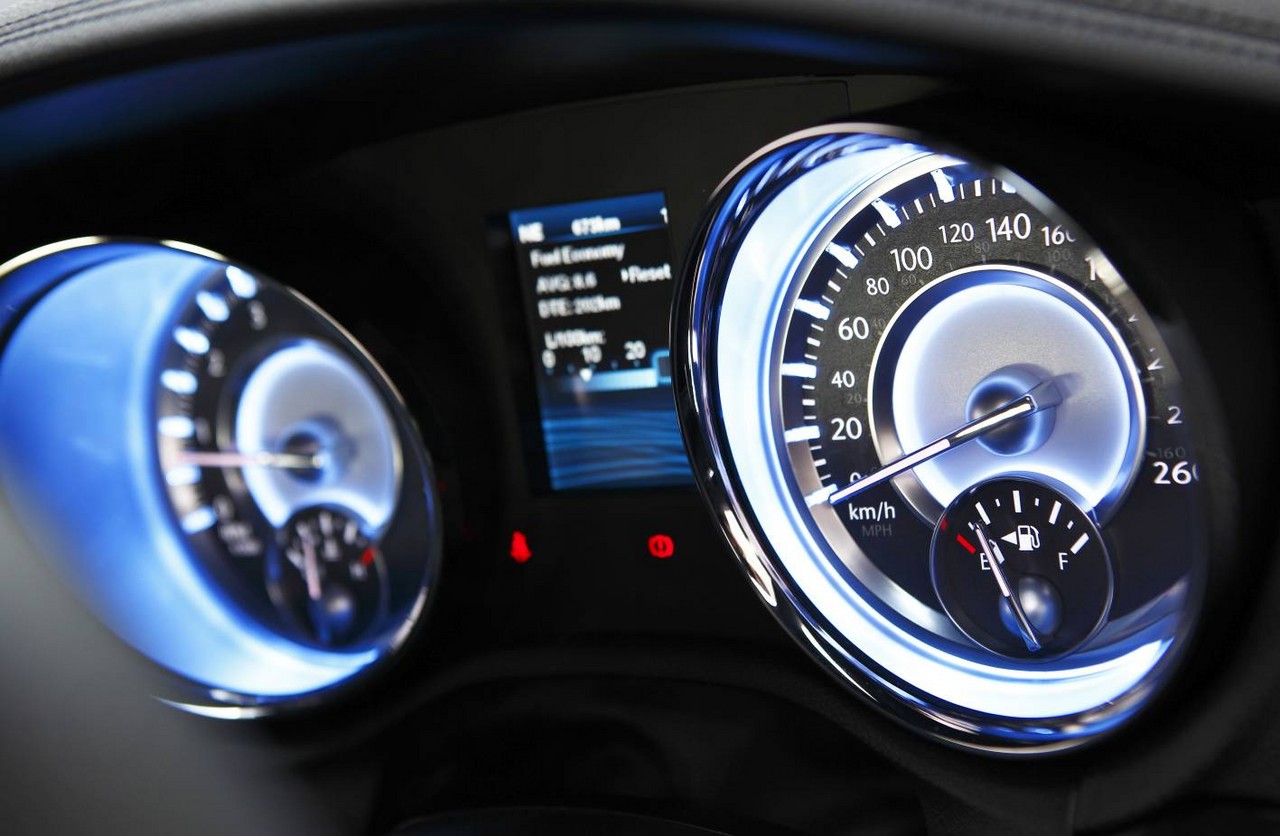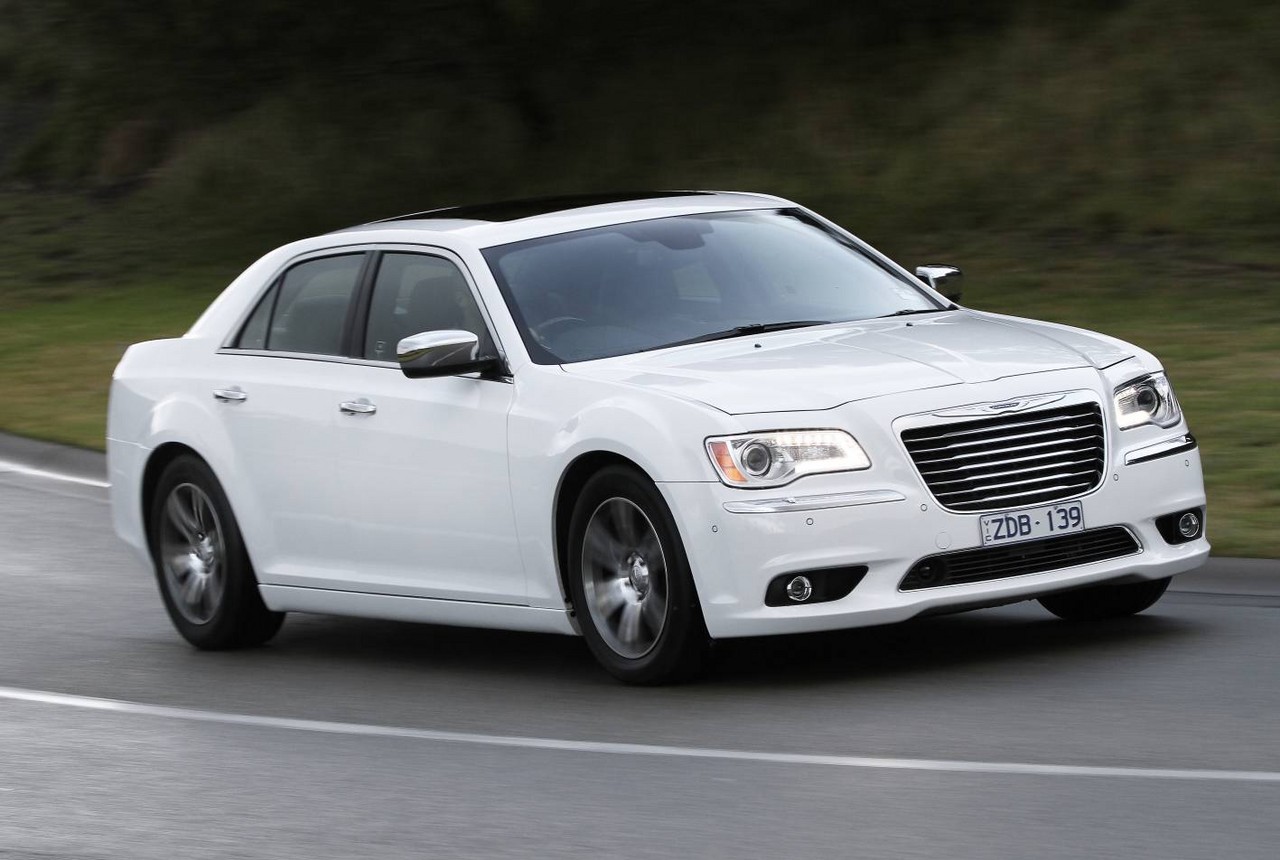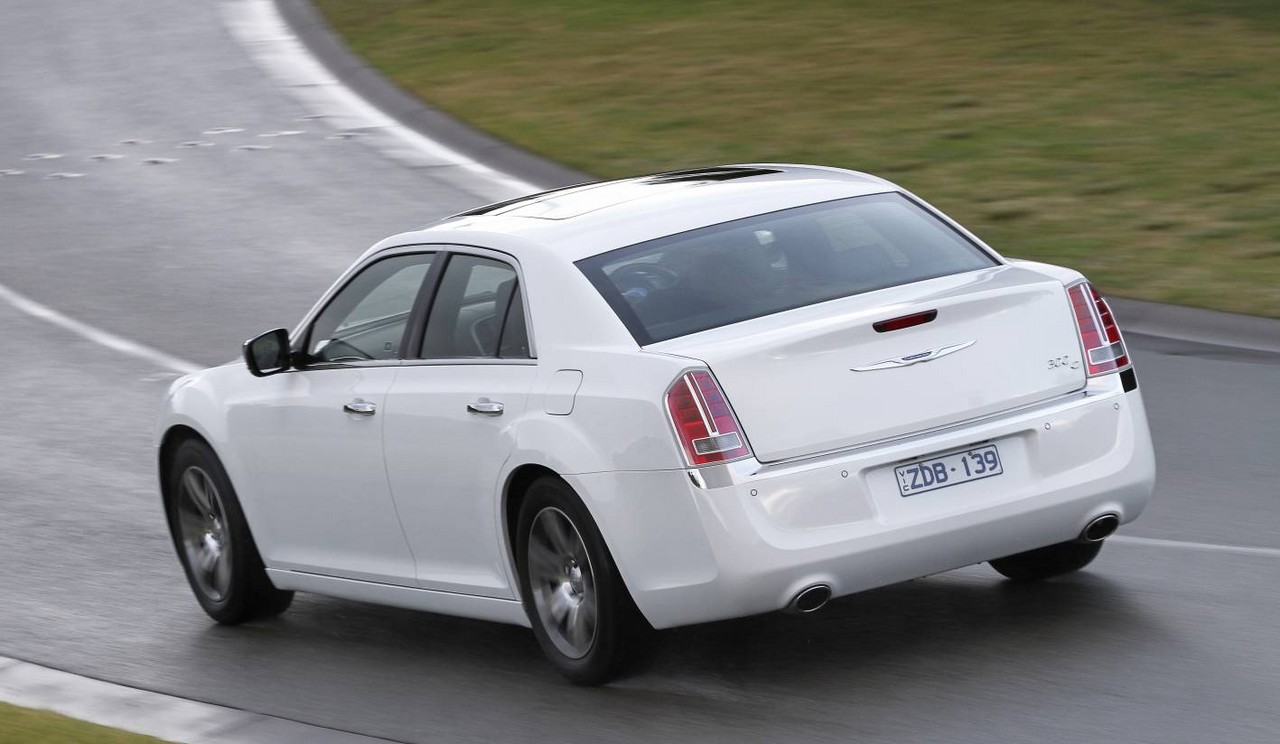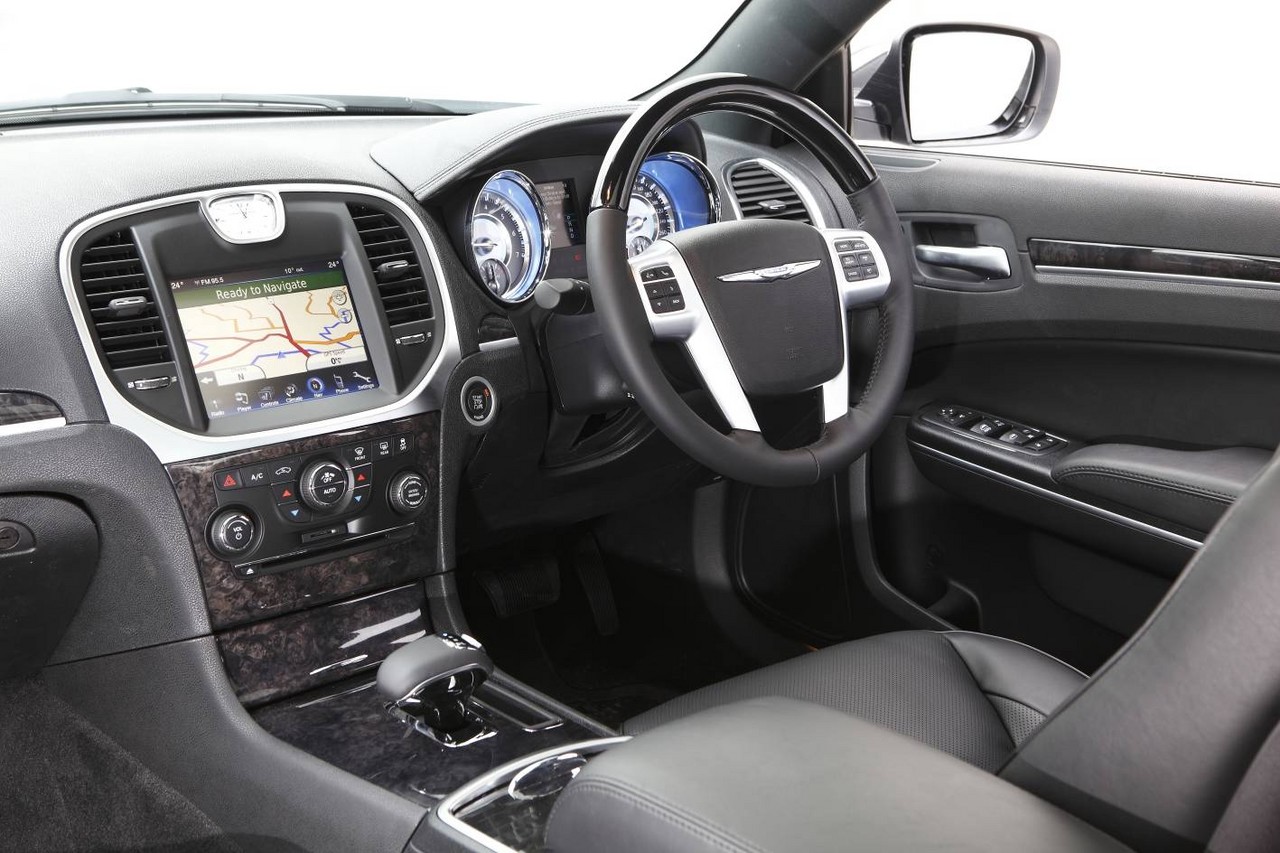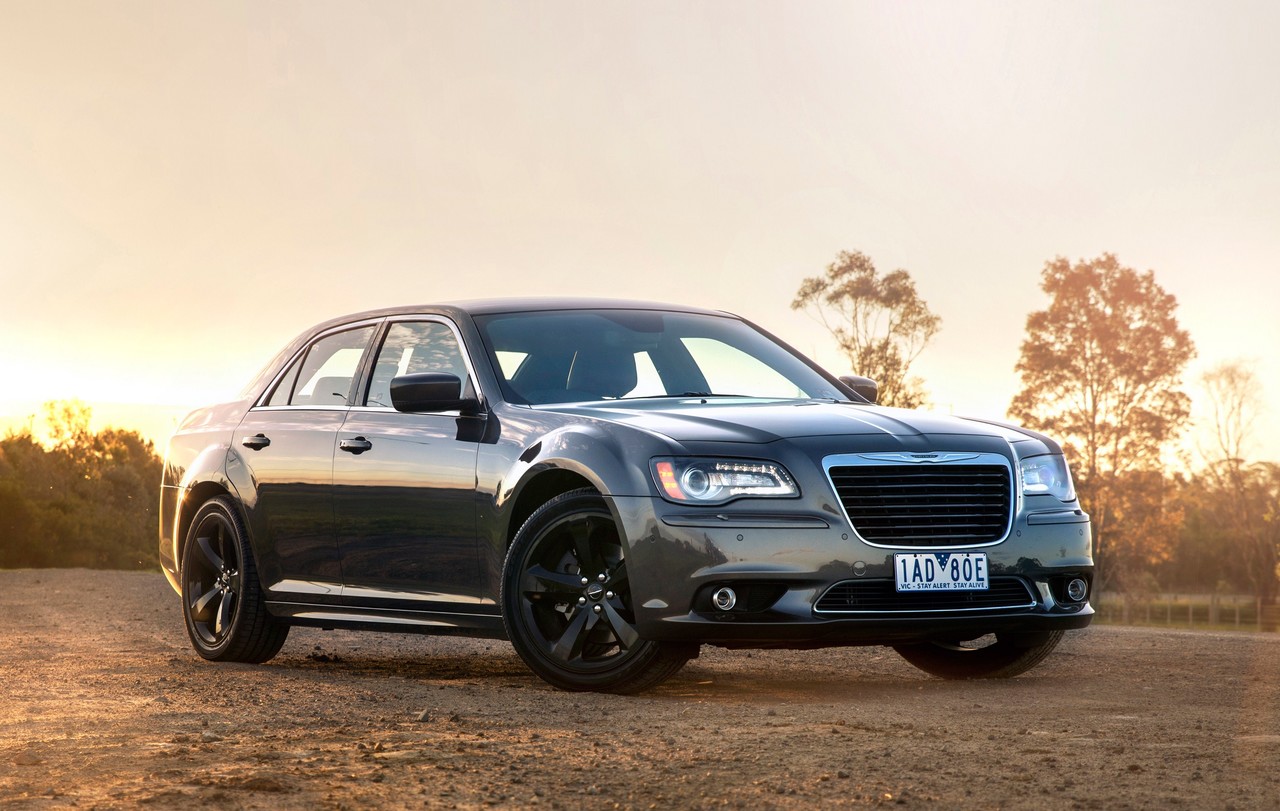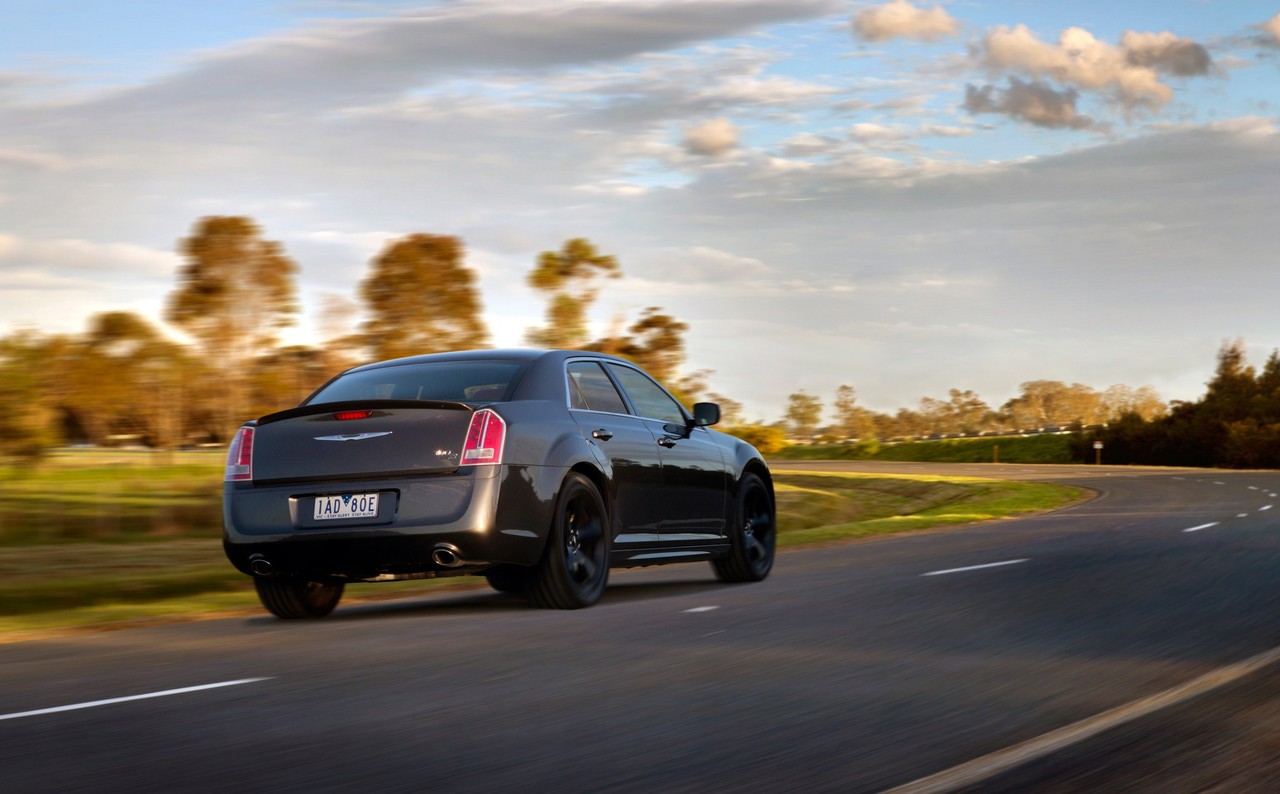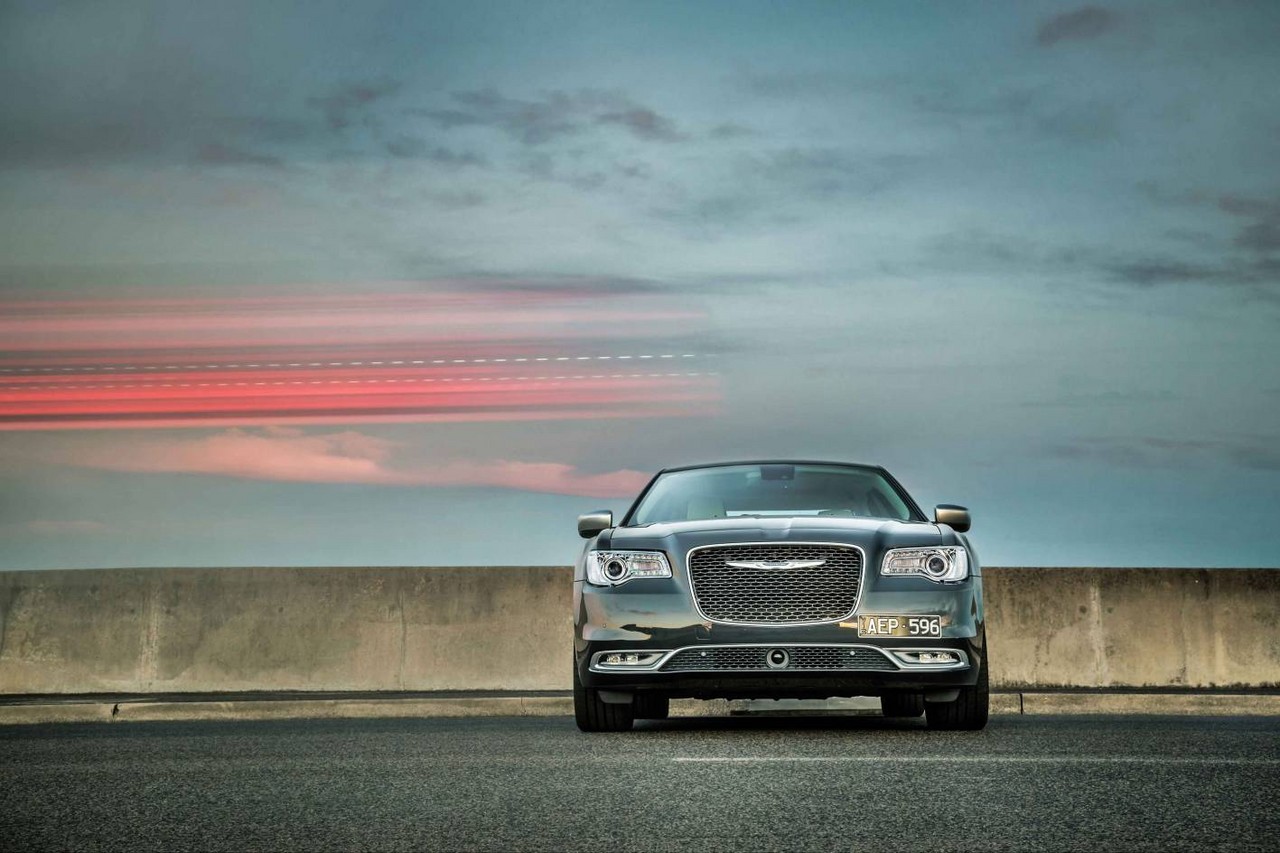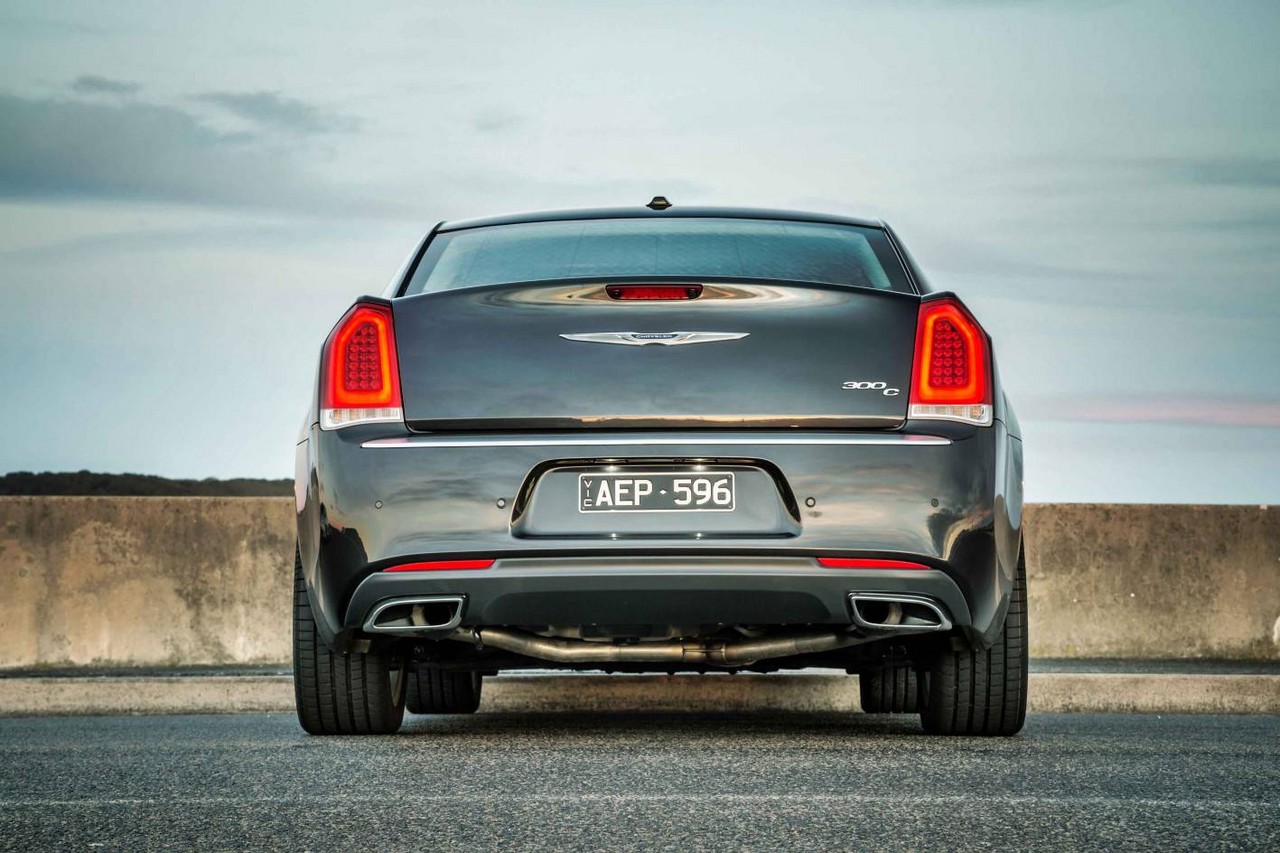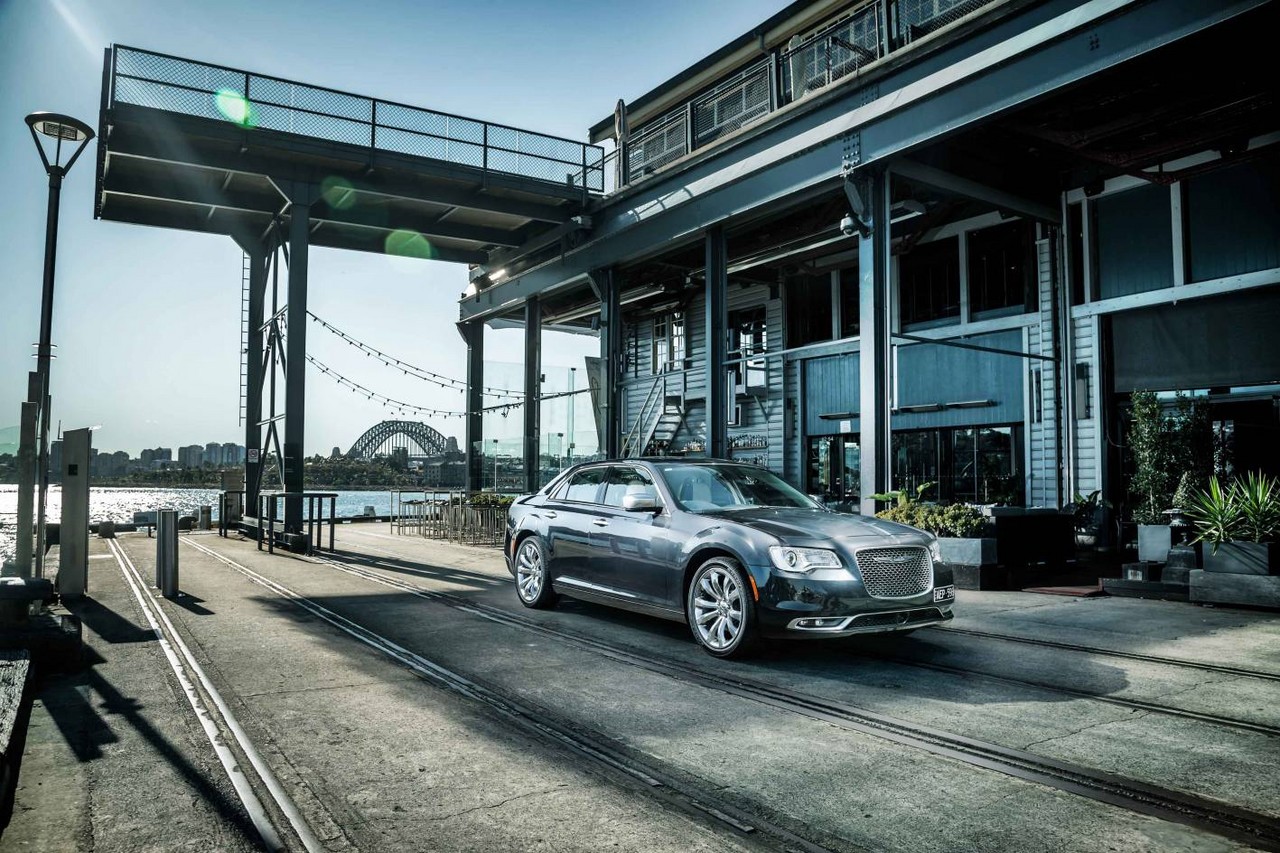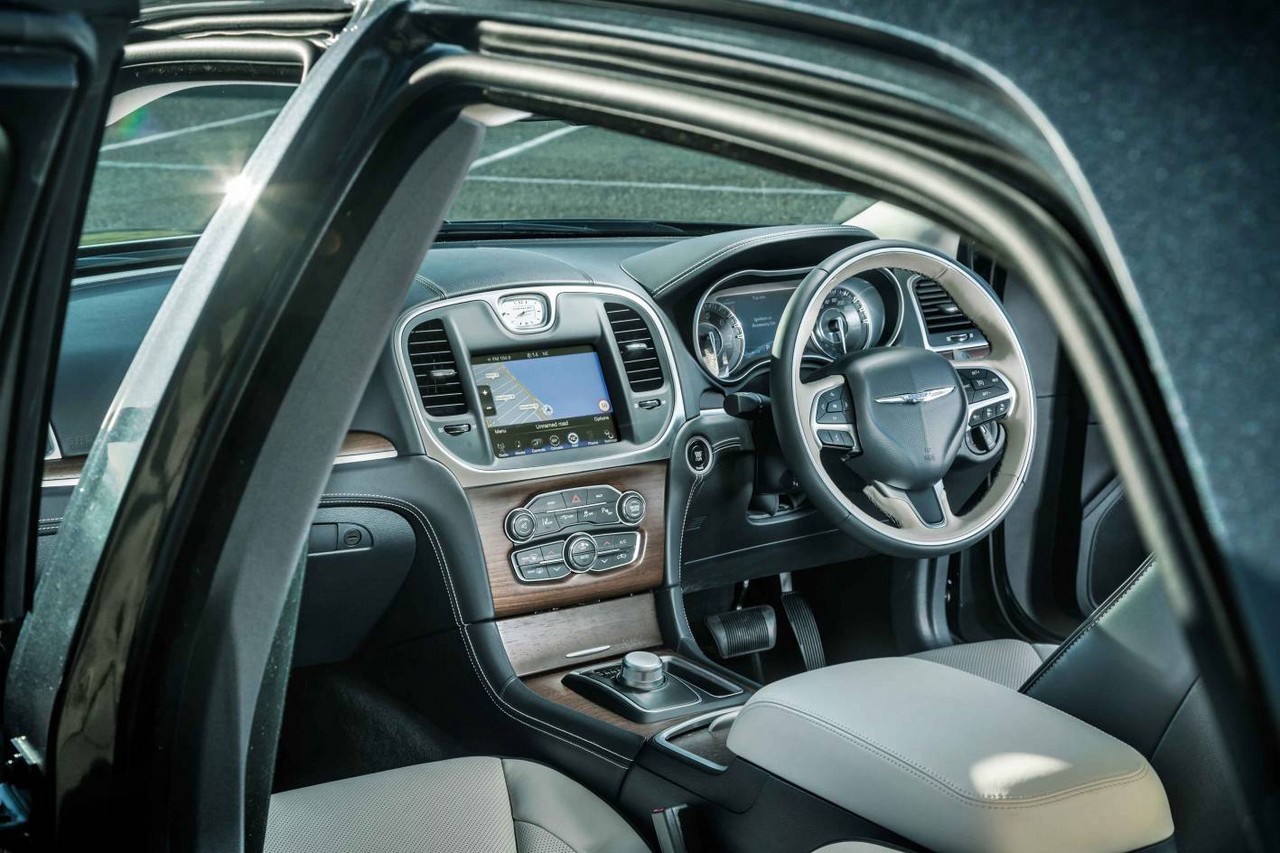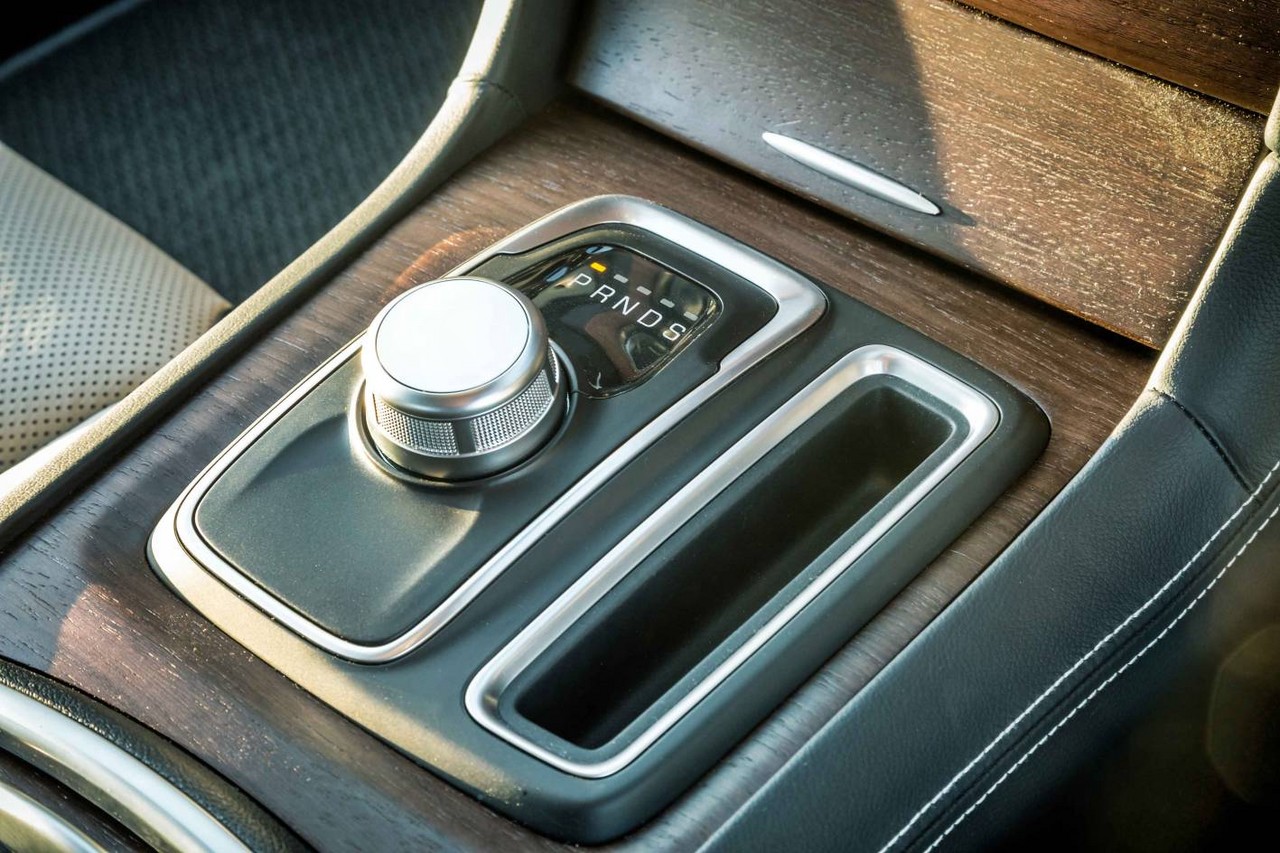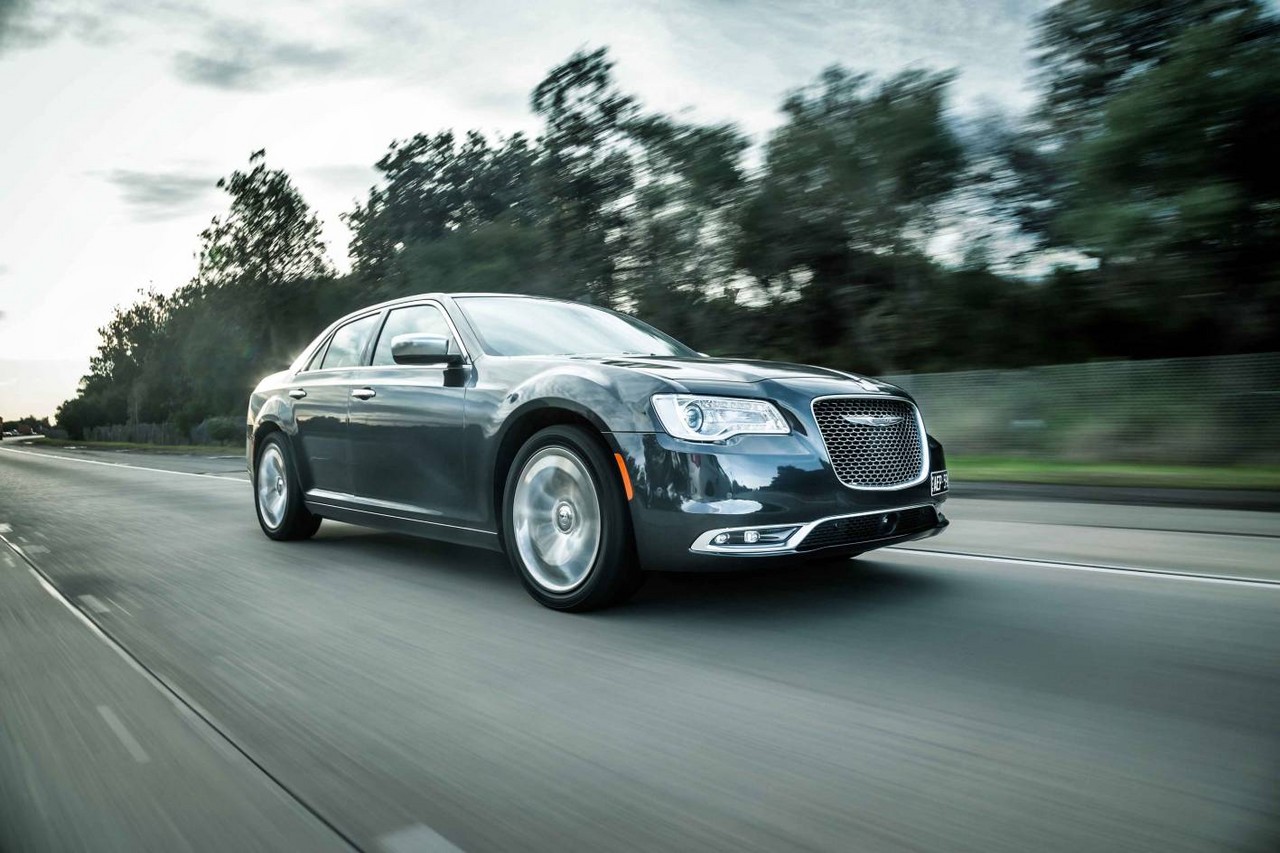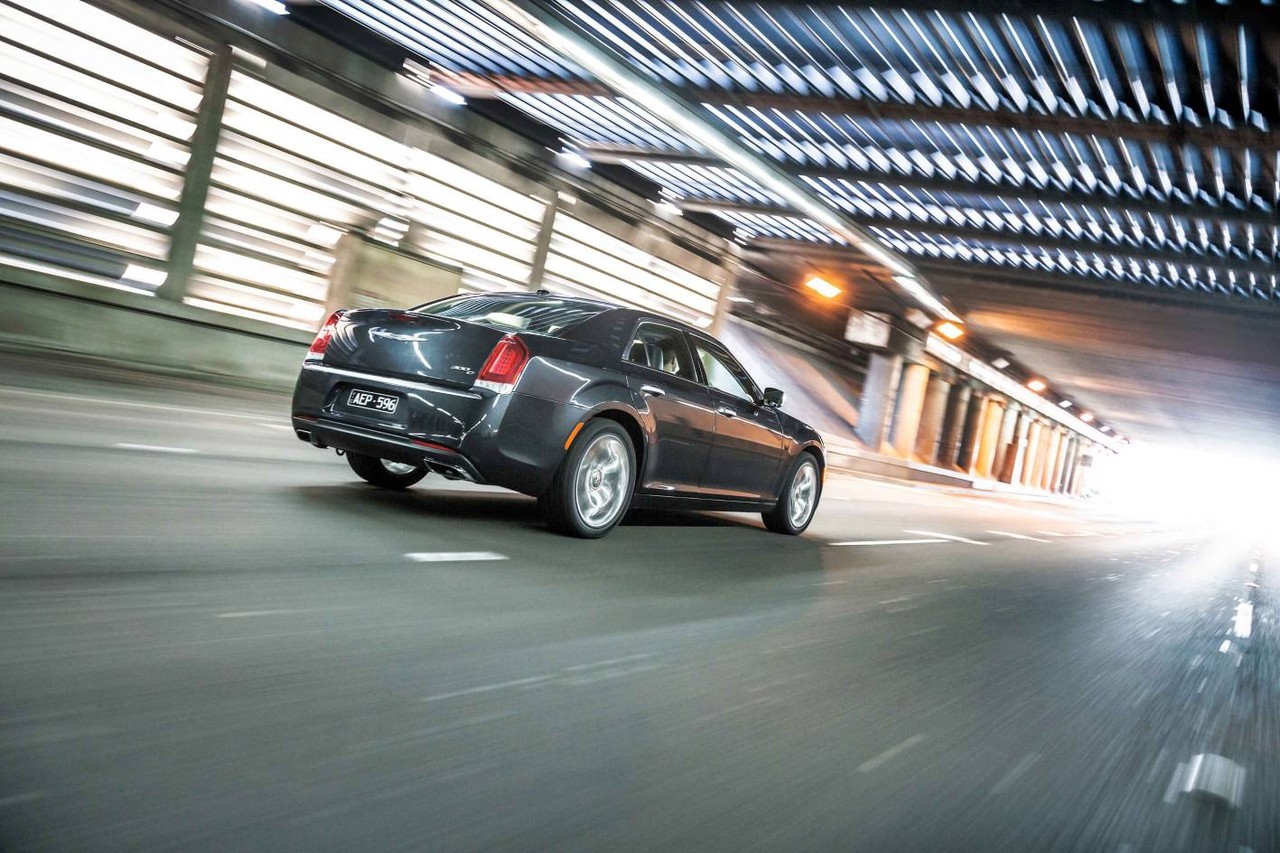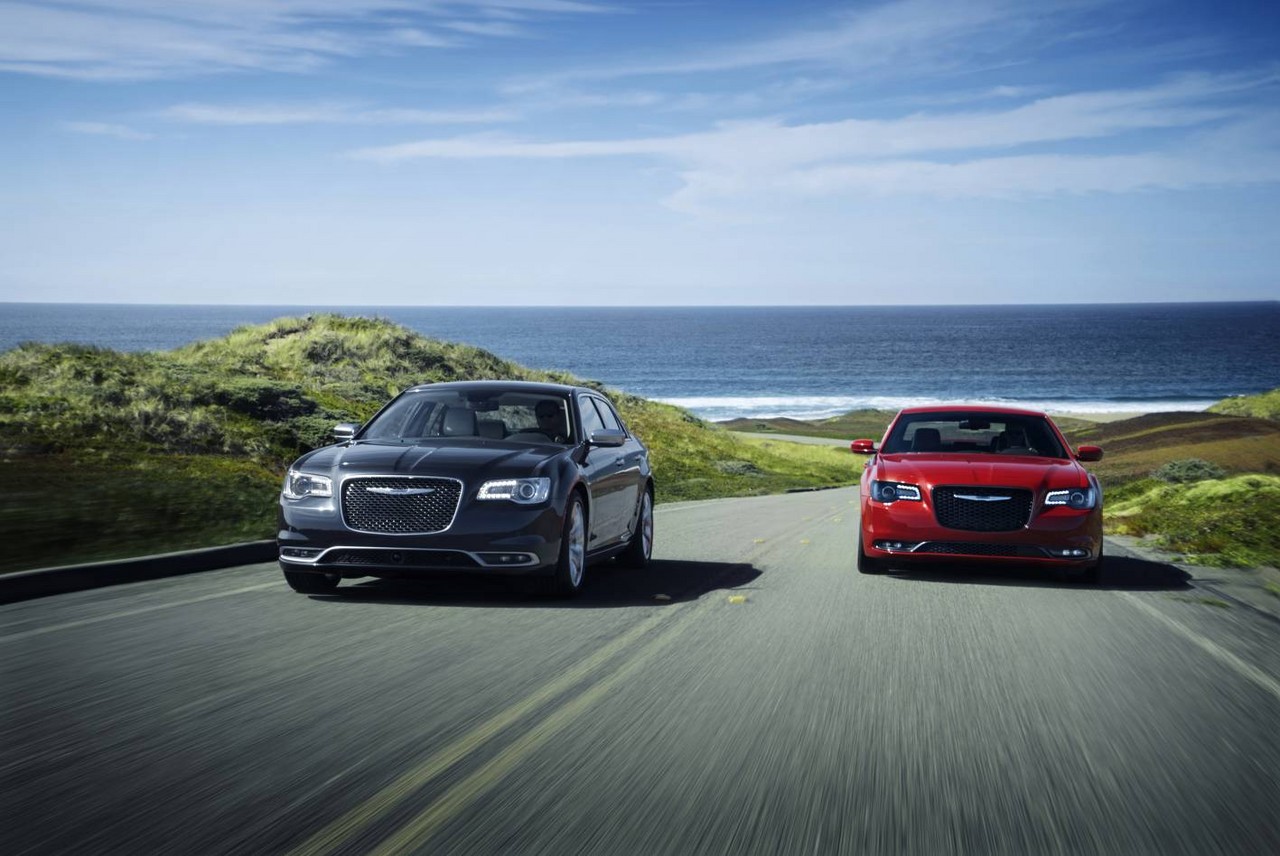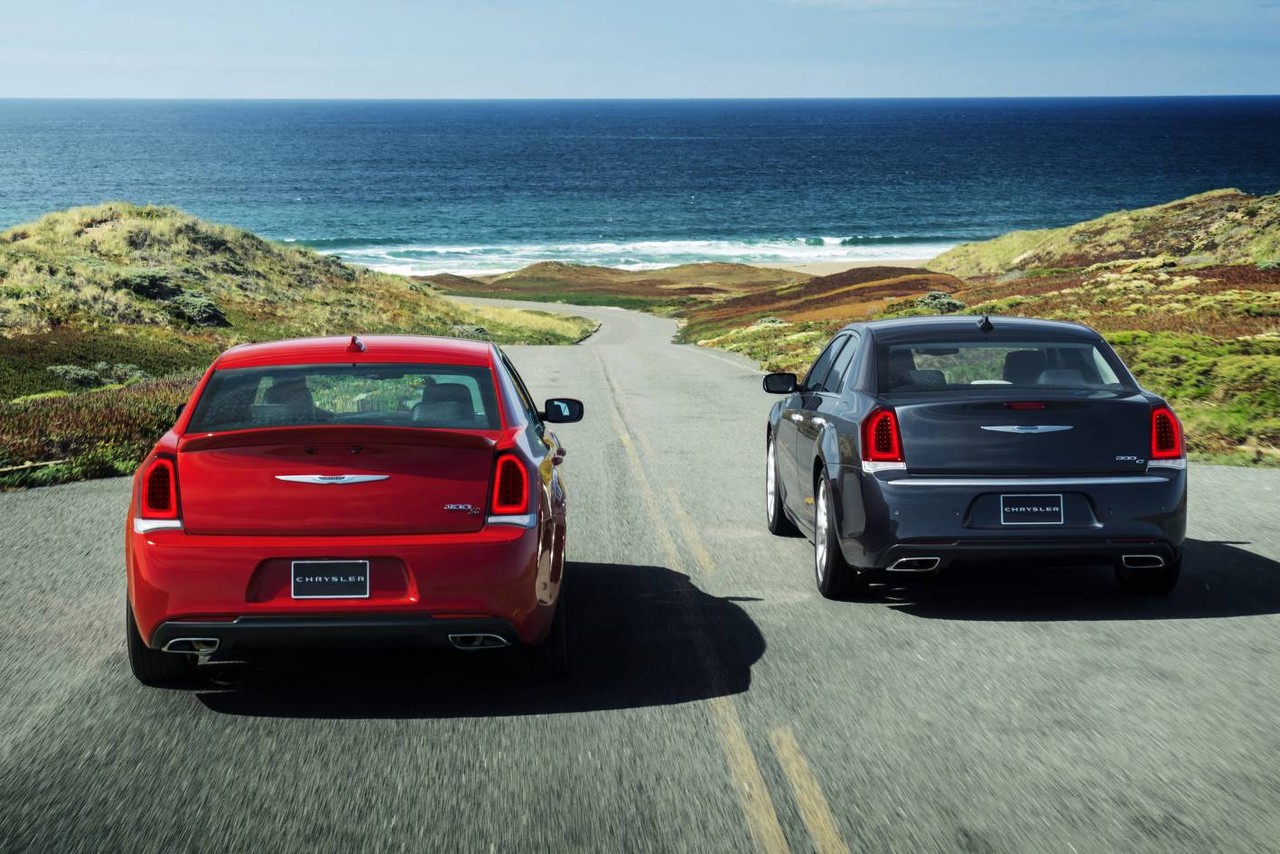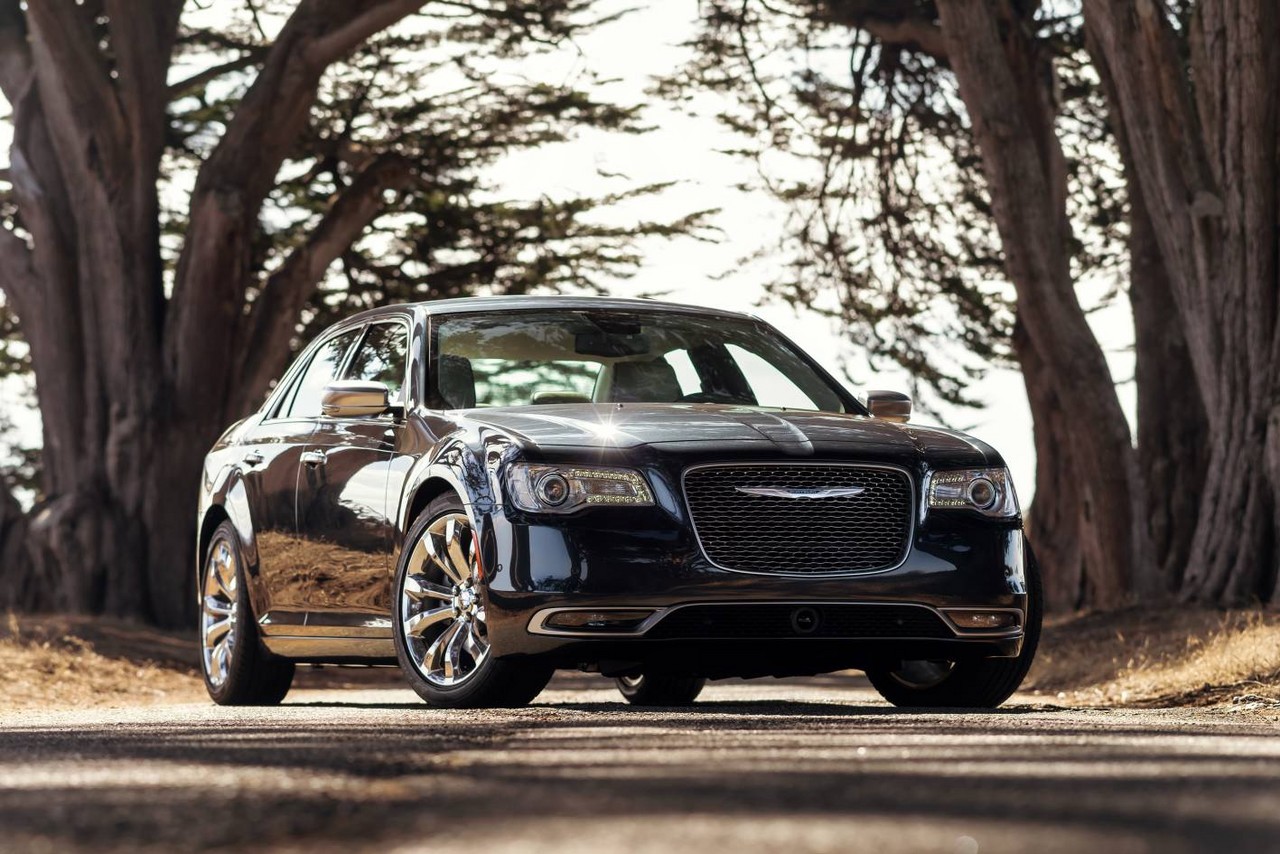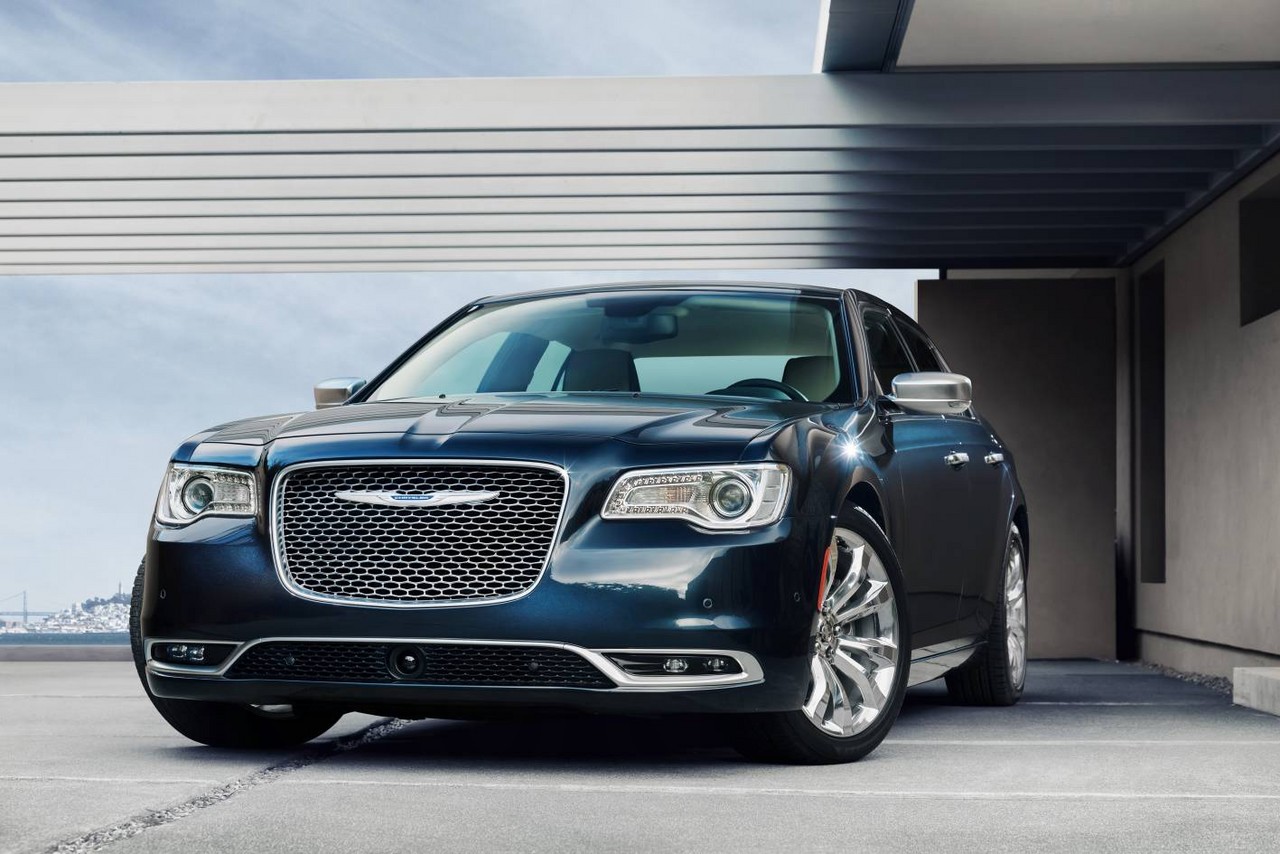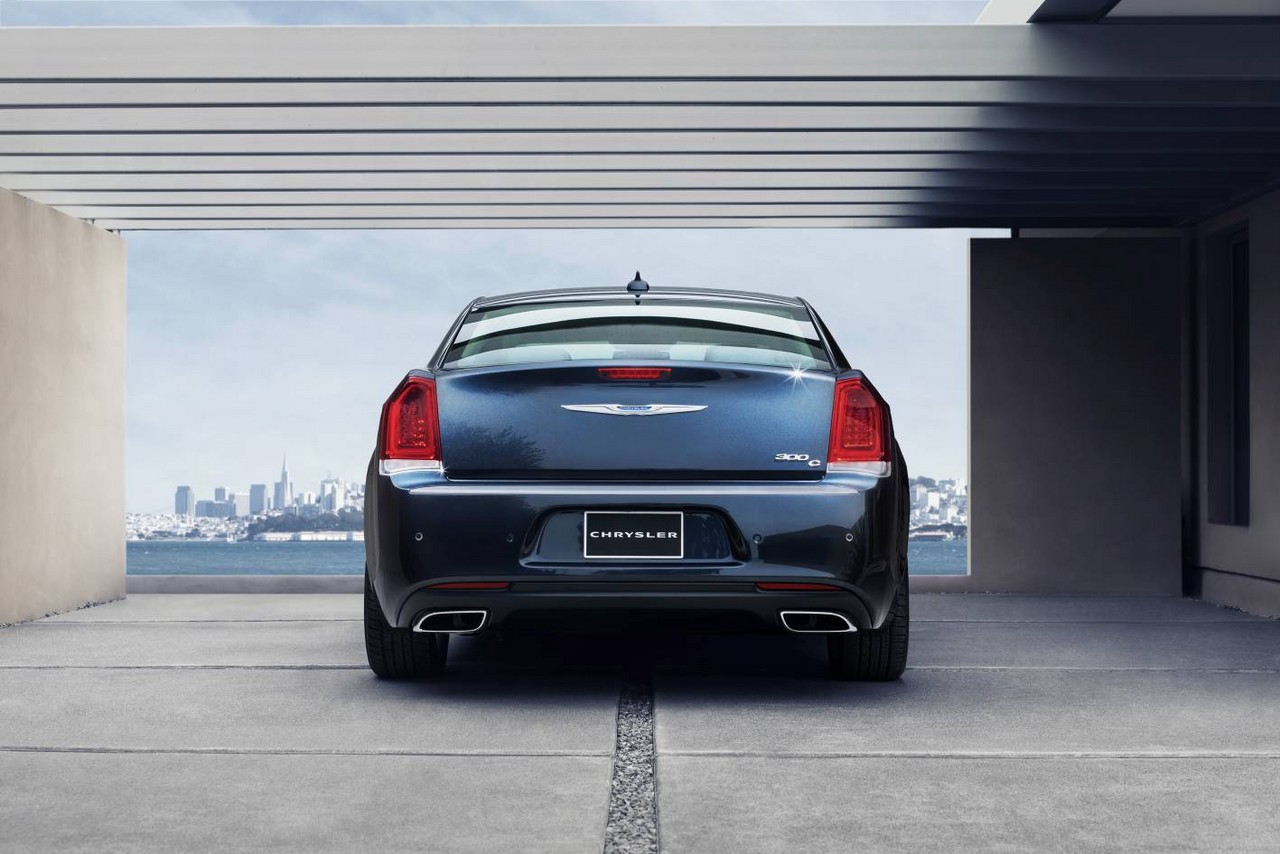
- Comfortable ride
- Refined eight-speed automatic transmission improves fuel economy
- Flexible V6 petrol engine
- 300 SRT-8 is an out-and-out muscle car
- Accurate, well-weighted steering
- Nose-heavy feel when cornering and tendency to understeer
- Outdated five-speed automatic transmission (for CRDi and SRT-8) has clumsy downshifts
- Dynamics fall short of the Holden VF Commodore and VF Calais
- High fuel consumption for 300 SRT-8
Review: Chrysler LX2.I 300 (2012-14)
Overview
Released in July 2012, the Chrysler LX2 Series I (LX2.I) 300 was a large, rear-wheel drive sedan. Manufactured in Brampton, Canada, the 300 was available with a choice of three engines: a 3.0-litre turbo-diesel V6 (the ‘3.0 CRDi’ variant), a 3.6-litre petrol V6 (‘3.6L V6’) and a 6.4-litre petrol V8 (‘SRT8’). Beyond the engine-based variants, the 3.0 CRDi and 3.6L V6 variants were offered in Limited, C and Luxury editions.
Engines: CRDi, V6 and SRT-8
Of the engines,
- the 3.0-litre VM Motori A630 diesel V6 engine had a graphite cast iron block with aluminium cylinder heads, a single Garrett VGT 2056 turbocharger, common-rail direct fuel injection, double overhead camshafts, four valves per cylinder, an integrated diesel particular filter and a compression ratio of 16.5:1;
- the 3.6L Pentastar V6 petrol engine had an aluminium block and cylinder head, double overhead camshafts, four valves per cylinder, variable valve timing and a compression ratio of 10.2:1; and,
- the 6.4L HEMI ESG V8 petrol engine had a cast iron block, aluminium cylinder head, two valves per cylinder actuated by pushrods, variable valve timing, displacement on demand (which enabled the engine to shut down four-cylinders under light throttle inputs) and a compression ratio of 10.2:1.
| Variant | Editions | Engine | Trans. | Peak power | Peak torque |
|---|---|---|---|---|---|
| 3.0 CRDi | Limited, C, C Luxury |
3.0-litre turbo-diesel V6 | 5sp auto | 176 kW at 4000 rpm | 550 Nm at 1800-2000 rpm |
| 3.6L V6 | Limited, C, S, C Luxury |
3.6-litre GCH petrol V6 | 8sp auto | 210 kW at 6350 rpm | 340 Nm at 4650 rpm |
| SRT8 | N/A, Core |
6.4-litre ESG petrol V8 | 5sp auto | 347 kW at 6100 rpm | 631 Nm at 4150 rpm |
Dimensions and body
Compared to the Chrysler LX 300C , the LX2 300 was 67 mm longer (at 5066 mm) and 24 mm wider (1905 mm), though height (1483 mm) and wheelbase length (3050 mm) were unchanged. Furthermore, the LX2 300 had a stiffer body as 67 per cent of the lower structure and 53 per cent of the upper structure were made from high-strength steels.
The LX2 300 provided greater refinement due to its premium-composite underbody panels, dual-pane acoustic windshield, body-cavity silencing foam, under-flush rolled-framed doors with triple seals and acoustic wheel-well liners.
Steering and suspension
The LX2 300 introduced a new electric steering system, although the SRT8 had a conventional hydraulic system. Furthermore, the LX2 300 had double wishbone front suspension and five-link rear suspension.
Safety equipment
Standard safety equipment for the Chrysler 300 included dual front airbags (dual-stage), a driver’s knee airbag, front seat-mounted side (thorax) airbags, full-length curtain airbags, ABS, electronic brake force distribution, electronic stability control, traction control and front seatbelts with pretensioners and load limiters. The 300 SRT8 variant and Luxury editions were further equipped with adaptive cruise control, a forward collision warning system and blind-spot monitoring.
Brakes
The 3.0 CRDi and 3.6L V6 variants were fitted with 345 mm by 28 mm ventilated front brake discs with 42 mm dual sliding piston calipers and 320 mm by 22 mm ventilated rear discs with 42 mm single piston calipers.
The 300 SRT-8, however, had 360 mm by 32mm ventilated front brake discs with 44 mm four-piston sliding Brembo calipers and 350 mm by 28 mm ventilated rear discs with 32 mm four-piston sliding Brembo calipers. Furthermore, brake cooling and fade performance were enhanced an underbody pan with integrated brake ducting.
Euro NCAP testing
In Euro NCAP testing , a Lancia Thema – as the Chrysler 300 was marketed in Europe – that was fitted with a 3.0-litre turbo-diesel engine received a five star safety rating which inclued an 83 per cent adult occupant protection rating and a 77 per cent child occupant protection rating. In the offset crash test, the driver’s head ‘bottomed out’ against the airbag and contacted the steering wheel rim; protection for the driver’s chest and head was assessed as adequate, though protection for the driver’s legs was marginal. Maximum points were awarded in the side impact test, though the pole test indicated marginal protection of the driver’s chest and adequate protection of the abdomen.
Features: Chrysler 300 Limited, C, S and Luxury
Standard features for the 300 Limited included 18-inch alloy wheels, a six speaker sound system with a 276 watt amplifier, MP3-compatiblity, auxiliary inputs (3.5 mm/USB), Bluetooth audio streaming and an 8.4-inch touch screen, power adjustable and heated front seats, dual-zone climate control air conditioning, cruise control, front fog lights, daytime LED running lights, bi-xenon headlights, automatic headlights, front and rear parking sensors, a reversing camera, a leather-wrapped steering wheel with audio controls, Bluetooth mobile phone connectivity, 60/40 split and folding rear seats, remote central locking with proximity key, power windows and heated mirrors, power folding mirrors, a height and reach adjustable steering wheel, tyre pressure monitoring, a trip computer, motion-sensing alarm and an immobiliser.
The 300 C was further equipped with 20-inch aluminium wheels, a nine speaker sound system with a subwoofer, 506 watt amplifier and CD/DVD player, a Garmin satellite navigation system, Nappa leather upholstery, heated and ventilated seats (front and rear), rain-sensing wipers, a heated steering wheel, voice recognition, driver memory settings (seat and door mirrors positions), a powered rear blind and cup holders with heating and cooling functions.
Released in November 2013, the 300 S was similarly equipped to the 300 C but could be identified by its 20-inch gloss black alloy wheels with Goodyear Eagle F1 Supercar tyres (as per the SRT8), black chrome grille with platinum surround, black headlamp bezels, body-coloured door handles and mirrors, bootlip spoiler and black-accented ‘Chrysler’ badging. Furthermore, the 300 S interior had a Piano Black finish for the centre console, steering wheel and door panels; sports pedals, contoured sports seats and matte carbon hydrographic-finished accents; as a no-cost option, the seats were available in red leather trim with contrast white stitching and embroidered ‘S’ logos.
Compared to the C editions, the 300 Luxury added 20-inch polished-face aluminium wheels, an upgraded ten speaker sound system, eight-way power adjustable front seats and steering wheel gearshift paddles. Visually, the Luxury editions could be identified by their platinum chrome trim for the grille, door mirrors and door handles; inside, there were satin chrome highlights and mocha wood accents.
Features: Chrysler 300 SRT8
The 300 SRT8 featured 20-inch forged-alloy wheels with 245/45 tyres, a 900 watt Harman Kardon sound system with 18 speakers and a ten-inch subwoofer, contoured sports seats with leather and suede trim, a heated steering wheel and carbon-fibre interior trim. Visually, the SRT8 could be identified by its unique mesh grille and bumper, side skirts and rear spoiler.
The SRT8 was also fitted with an Adaptive Damping Suspension (ADS) system that adjusted suspension damping according to vehicle speed, steering angle, steering inputs, brake torque, throttle position and lateral and vertical acceleration inputs; drivers were also able to select from ‘Auto’ and ‘Sport’ settings.
Chrysler 300 SRT8 Core
Released in April 2013, the SRT8 Core had the same drivetrain as the SRT8 but omitted:
- Adaptive cruise control, the forward collision warning system and blind-spot monitoring;
- 20-inch forged alloy wheels (instead fitted with cast alloy wheels);
- Adaptive Damping Suspension (instead fitted with conventional dampers and self-leveling rear suspension);
- The Harman Kardon sound system (instead fitted with the standard six speaker sound system);
- The satellite navigation system and reversing camera;
- Leather seats (instead fitted with ‘Ballistic’ cloth seats), front seat heating and ventilation, and heated rear seats;
- Fog lights;
- Heated and cooled cup holders; and,
- Carbon fibre accents (replaced with matte carbon).
2014 Chrysler 300 SRT8 Core Satin Vapour
Based on the SRT8 Core, the SRT8 Core Satin Vapour was produced in late 2014 and added a satellite navigation system, leather trim seats with perforated suede, a rear view camera and dual-pane panoramic sunroof.
Visually, the SRT8 Core Satin Vapour could be identified by its satin black aluminium wheels with red brake calipers, black chrome/gloss black grille, satin black mirror caps, gloss black window surrounds, body colour fascia with black/chrome accents, satin black roof wrap, satin black rear spoiler, SRT lower black stripe and ‘6.4L Hemi’ gloss black fender badge
Available in Billet Silver, Bright White or Granite Crystal paint finishes, Australian deliveries of the 300 SRT8 Core Satin Vapour were limited to 133 vehicles.
Related links
- Technical Specifications: Chrysler LX2 300 (July 2012)
- Accessories Brochure: Chrysler LX2.I 300 (July 2013)
Review: Chrysler LX2.II 300 (2015-on)
Overview
Released in Australia in July 2015, the Chrysler LX2 Series II (LX2.II) 300 was initially powered by 3.6-litre V6 petrol engines and offered in C and C Luxury editions. In August 2015, the performance-oriented SRT and SRT Core were released, powered by 6.4-litre V8 petrol engines.
The Chrysler LX2.II 300 could be identified by its taller and more prominent front grille which contains the Chrysler wing badge, signature LED lighting, new finishes and alloy wheel designs. Inside, the Chrysler 300 had a new seven-inch full colour driver information display (DID) for the instrument cluster, an electronic rotary transmission shifter (Chrysler’s ‘Rotary E-Shift’) and a new three-spoke steering wheel.
For both the 300 V6 and SRT models, engineering changes included a new electric power steering system and new cast-aluminium axles and axle housings to reduce mass and frictional losses.
| Variant | Editions | Engine | Trans. | Peak power | Peak torque |
|---|---|---|---|---|---|
| 3.6L V6 | C, C Luxury |
3.6-litre GCH petrol V6 | 8sp auto | 210 kW at 6350 rpm | 340 Nm at 4650 rpm |
| SRT | Core, N/A |
6.4-litre ESG petrol V8 | 8sp auto | 350 kW at 6150 rpm | 637 Nm at 4250 rpm |
Safety equipment
Compared to its LX2.I predecessor, standard safety equipment for the Chrysler 300 C was unchanged. The Chrysler 300 C Luxury and 300 C SRT, however, were further equipped with:
- Full-speed Forward Collision Warning-Plus: used radar sensors and a camera to determine if a frontal impact was imminent. If so, the system would prepare the brakes and issue audible and visual warnings to the driver. If the driver failed to respond, the brakes would be briefly applied as an additional alert. If the driver still did not react and the frontal collision risk persisted, the brakes were applied automatically to reduce the severity of the collision;
- Advance Brake Assist: if inadequate force was applied to the brakes in response to a signal from Full-Speed Forward Collision Warning-Plus, Advance Brake Assist would increase braking force;
- Adaptive Cruise Control Plus with Full Stop: could maintain a distance from the vehicle ahead, bring the vehicle to a complete stop rest, hold for two seconds and then accelerate when traffic began to move;
- ‘LaneSense’ Lane Departure Warning: could detect if the vehicle had departed from its lane and would provide an audible warning to the driver;
- Lane Keep Assist: used the electric power steering system to direct the vehicle back to its lane;
- Blind Spot Monitoring: used dual ultra-wideband radar sensors to detect vehicles approaching from behind or in the driver’s blind spot and warn the driver via illuminated icons in the door mirrors and a selectable audible tone; and,
- Rear Cross-Path Detection: could detect traffic which may cross the vehicle’s intended path as it was reversing.
Features: Chrysler 300 C
Standard features for the Chrysler 300 C included 18-inch polished alloy wheels with 235/55 R18 BSW touring tyres, Nappa leather-trimmed upholstery, an Alpine sound system with nine speaker (including subwoofer) and a 506 watt amplifier, DAB+ digital radio, satellite navigation with Chrysler’s 8.4-inch UConnect touchscreen, Bluetooth mobile phone connectivity and audio streaming, dual-zone climate control air conditioning, ventilated front seats, heated front and rear seats, cruise control, directional bi-xenon headlights, LED fog lights and daytime running lights, a rear view camera with dynamic guidelines (Chryler’s ‘ParkView’), front and rear parking sensors (‘ParkSense’), 60/40 split and folding rear seats, a heated steering wheel with wood and leather trim, remote central locking with proximity key (i.e. keyless entry), power windows, power adjustable and heated door mirrors with folding function, a height and reach adjustable steering wheel, driver memory settings (for the driver’s seat and mirror position), auto-dimming interior and rear-view mirrors, push-button and remote start, floor mats, tyre pressure monitoring, floor mats, a trip computer, an alarm and immobiliser.
The Chrysler 300 C also had a rotary gear selector which could engage an ‘S’ mode that provided greater throttle response, adjusted transmission behaviour and enabled faster gear shifts (250 ms compared to 400 ms).
Features: Chrysler 300 C Luxury
The 300 C Luxury was fitted with Chrysler’s sports suspension and had a ‘Sport’ button which provided ‘sport-tuned steering’ with greater weight (in addition to the greater throttle response and adjusted transmission behaviour of ‘S’ mode)
Compared to the 300 C, the Chrysler 300 C Luxury was further equipped with 20-inch polished alloy wheels with 245/45Z R20 BSW performance tyres, quilted Nappa leather upholstery, automatic headlights, rain-sensing wipers, a hand-stitched leather steering wheel and steering-wheel gearshift paddles.
Features: Chrysler 300 SRT
Standard features for the Chrysler 300 SRT Core included 20-inch ‘satin black’ machine-faced aluminium wheels with 245/45 ZR20 BSW performance tyres, a six speaker sound system with a 276 watt amplifier, Chrysler’s 8.4-inch ‘UConnect’ touchscreen, DAB+ digital radio, Bluetooth mobile phone connectivity and audio streaming, dual-zone climate control air conditioning, ‘SRT Performance’ cloth seats, cruise control, directional bi-xenon headlights, LED fog lights and daytime running lights, a rear view camera with dynamic guidelines (Chryler’s ‘ParkView’), front and rear parking sensors (‘ParkSense’), 60/40 split and folding rear seats, a leather-wrapped steering wheel with paddle shifters, remote central locking with proximity key (i.e. keyless entry), power windows, power adjustable and heated door mirrors with folding function, a height and reach adjustable steering wheel, driver memory settings (for the driver’s seat and mirror position), auto-dimming interior and rear-view mirrors, push-button and remote start, floor mats, tyre pressure monitoring, floor mats, a trip computer, an alarm and immobiliser.
As standard, the 300 SRT was also fitted with a mechanical limited slip differential. The driver could also engage a ‘Sport’ mode which provided a unique steering calibration, enabled the steering wheel gearshift paddles, provided greater throttle response, a more sporting transmission calibration and faster gearchanges (in as little as 250 ms).
The Chrysler 300 SRT was distinguished by its 20-inch polished and forged aluminium wheels, Harman Kardon audio system with eighteen speakers, an eight-inch subwoofer and 900-watt amplifier, satellite navigation system, Nappa leather and Alcantara upholstery, ventilated front seats, heated front and rear seats, rain-sensing wipers, a heated steering wheel, temperature-controlled front cupholders, carbon fibre interior trim and door mirror courtesy lamps. The 300 SRT also had Adaptive Damping Suspension (ADS) which enabled the driver to select from three settings –
- Default;
- Sport: provided a higher damping rate; and,
- Track: combined the higher damping rate of Sport mode with faster gearshifts and a transmission calibration to hold gears for longer.
Related links
- Fiat Chrysler Australia: Chrysler 300
- Wikipedia.org: Chrysler 300
- Behind the Wheel: 2014 Chrysler 300 S Review
